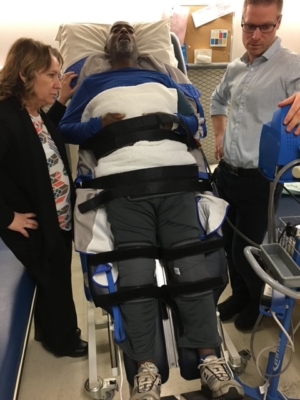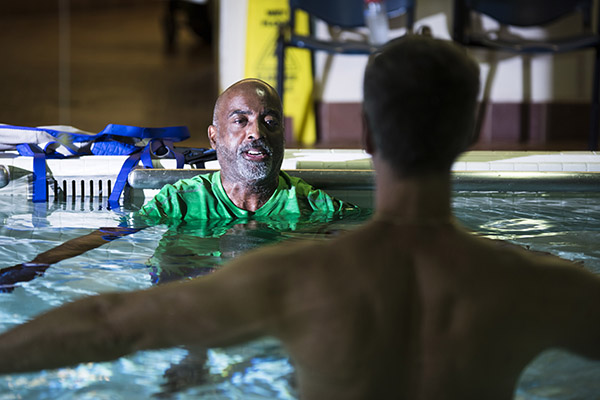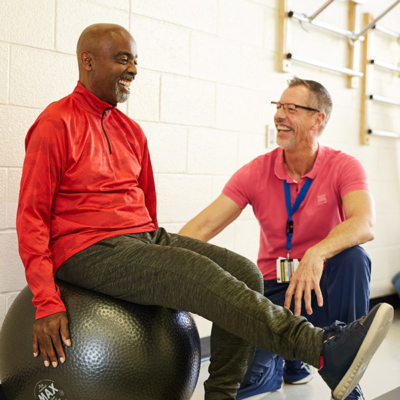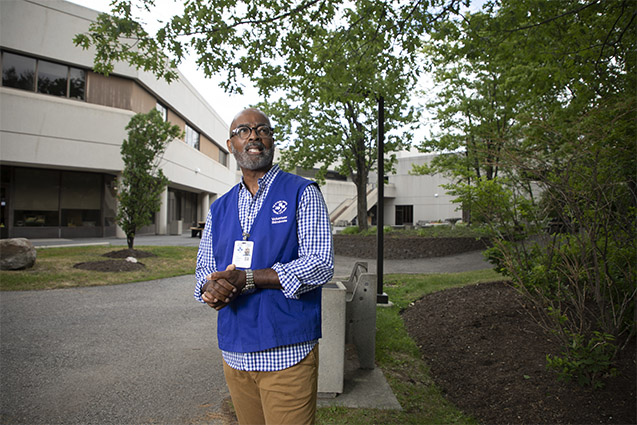Girl Walks Again After Guilain Barre Syndrome
Long-distance cyclist Fran Cosper described himself as being in the best shape of his life as he headed into the winter of 2017. However, in mid-February he woke up in the middle of the night unable to experience his legs. The side by side morning, when Fran tried getting out of bed, he slammed onto the floor – his strong legs of a sudden useless. Soon after, he was diagnosed with Guillain Barré Syndrome (GBS) – facing the possibility of permanent paralysis. Little did he know the road ahead would involve a team of experts, the help of 3D virtual reality at The Ottawa Infirmary, and a determination non only to walk again, merely also to assistance other patients.
When Fran kickoff experienced those sudden symptoms, he initially idea it couldn't exist anything serious as he was very health conscious. He attempted to make his fashion to the basement that morning to work out. "I went to go on my hands and knees, and fell face-first on the carpet. I thought, 'Well, I can't motion. This is much more than serious.' My wife, Elise, came downwards and saw that I had facial paralysis, and thought I'd had a stroke."
Just Fran knew that strokes typically affect only one side of the body and that something else — something serious — was happening.
What is Guillain Barré Syndrome?

Afterwards a thorough cess, Fran was diagnosed with GBS. This rare autoimmune disorder causes the immune system to attack the nerves, damaging the myelin sheath, which is the nerves' protective roofing. As a result, the brain tin't transmit signals to the nerves in the muscles, causing weakness, numbness or, equally in Fran's instance, paralysis.
An infection or virus can bring on GBS. The 56-year-old had had two colds back-to-dorsum, which may take thrown his allowed arrangement into overdrive. Inside days, his balance was off, and he had difficulty lifting pots to melt dinner. Hours later on, the disease was full diddled, attacking his nervous system and Fran couldn't move.
"It was like having an out-of-body experience. I mean my brain was working fine simply my body wasn't doing what I asked it to exercise."
– Fran Cosper
"We see patients with Guillain Barré Syndrome at The Ottawa Hospital Rehabilitation Centre probably five or half-dozen times a yr," says Dr. Vidya Sreenivasan, a dr. of physical medicine and rehabilitation. Some have mild cases, only others, like Fran's, are more serious.
A more challenging road to recovery
Most one in 100,000 Canadians contracts GBS every year. Recovery tin can take more a twelvemonth considering the nerves re-abound slowly, one millimetre per month. For Fran, the journey would be much longer.
The affliction continued its nerve damage following his access to the hospital. After two weeks, he transferred to the Rehab Middle, where his intendance team included doctors, psychologists, social workers, recreation therapists, physiotherapists, respirologists, occupational therapists, and nurses.
"I decided at that point, I was going to fight it. I was going to fight back and practice the best I could to become improve even though I didn't know what the outcome was going to exist."
– Fran Cosper
Fran was completely dependent on this squad for all of his intendance. He needed to be washed, dressed, and turned in bed. He couldn't even shut his eyes. The nurses had to tape his eyelids shut and then he could sleep.
"Information technology was like having an out-of-trunk feel. I hateful my brain was working fine merely my body wasn't doing what I asked information technology to practice," says Fran. He also faced excruciating hurting because of the damage washed to his nerves. Equally Fran lay there unable to motion in his hospital bed, he fabricated a decision.
"Oddly, I wasn't agape. I decided at that point, I was going to fight information technology. I was going to fight back and do the best I could to get amend even though I didn't know what the outcome was going to be."
Rehab team gear up with state-of-the art engineering
Fran's fantabulous fitness level, as well every bit his determination and positive mental attitude, helped him through when it came to the rigorous therapy programme. He had physiotherapy five hours a day, including three times a calendar week in the Rehab Centre pool. Within two months, he could stand and take steps with help. He learned to walk again thanks in part to our Virtual Reality lab – 1 of merely two in Canada.

"The pool and this 3D room were invaluable. It would have taken me a lot longer to get my legs back if I didn't have access to those tools." – Fran Cosper
The CAREN (Calculator-Assisted Rehabilitation Environs) organization combines room-sized 3D graphics, a platform that moves with the patient in a harness, as they explore the 3D world, a dual-tread remote-controlled treadmill, and world-class move assay technology. Preprogrammed visual presentations allow the patient to respond to an environmental stimulus by shifting weight, increasing or decreasing speed and even making specific motions. Difficulty levels can be increased gradually as the patient progresses further in their rehabilitation treatment plans.

"This room is correct out of sci-fi. It really challenges your body. After an hour of doing exercises, I was only sweating. The pool and this 3D room were invaluable. Information technology would accept taken me a lot longer to get my legs back if I didn't have access to those tools."
"I'd basically been swiped off the planet for a year. Simply the merely negative matter well-nigh being in the infirmary was the disease itself." – Fran Cosper
For Dr. Nancy Dudek, Medical Director, Amputee Program at The Ottawa Hospital Rehabilitation Middle, this unique system offers many benefits to patients. "There's no stop to things you tin can exercise with that sort of creativity. To exist able to be hooked up to a harness without the support of the parallel bars still gives y'all the safety aspect. It's a very innovative and beneficial arrangement."
Installed in 2010 in partnership with the Canadian Forces and with back up from the community, the CAREN system was initially used in function to assistance injured soldiers returning from Transitional islamic state of afghanistan. Since then, many patients accept benefitted, including those who have had a traumatic encephalon injury, stroke, neuromuscular illness, amputation, or chronic pain.
Continuing the route to recovery
Released from the Rehab Center in October 2017, tears were shed by Fran and nurses who cared for him. It was those nurses who helped Fran with day-to-twenty-four hours care, teaching him how to launder and dress himself and be independent again.

"I can honestly say that the kindness and level of intendance I got really humbled me. The nurses and staff have only been marvellous," says Fran. "I'd basically been swiped off the planet for a year. But the but negative thing about existence in the hospital was the disease itself."
He walked out of the Rehab Centre using a walker. When he returned a month afterwards for a follow-upwards date, he walked in on his own.
Today, Fran is back riding his bike – non quite to the 100-kilometer distances, yet, but his therapy continues. He still deals with hurting, and his arms were slower to recover. His fine motor skills in his fingers are taking longer to get back to normal. As a saxophone actor, he's motivated to go his fingers working again.
"I'm kind of at the point at present where I'm thinking I may be able to play again anytime. I'm hopeful that I'll be able to play my sax because my fine dexterity is improving – it's a work in progress."
Giving back equally a volunteer
Fran will never forget 2 volunteers in particular who were there for him when he was being cared for at the Rehab Heart. Chris and Claude would come and take Fran for coffee and to talk. Initially, he had no idea who these blueish-vested people were, just Fran quickly learned the important role they play at the hospital.
"I remember asking Chris why he was a volunteer. Chris explained to me that he had an inoperable brain tumour, and he was going to die. He told me, 'I figured the hospital took such expert care of me that I would spend the residuum of my time volunteering.' I broke into tears and decided right at that place I had to become a volunteer," says Fran.

Pre-COVID, Fran would spend ii days a calendar week coming together patients, sometimes visiting his quondam room at the Rehab Centre, inspiring them about what is possible. "I call up seeing a woman in a hallway; she was on a gurney and going in for surgery – she was by herself. I stopped, leaned over, and told her information technology was going to exist ok. Afterwards, I saw her again and she said, 'Thank you.'"
That'due south why Fran proudly wears the blueish vest. He's experienced the night days and today, he'south happy to be able to assist others when they need a reassuring vox to help them through – just like Chris and Claude helped him. He'south also grateful to be able to volunteer his time at the hospital that cared for him during his long journey to recovery.
Listen to Fran Cosper in his own words during a guest appearance on Pulse: The Ottawa Infirmary Foundation Podcast.
The Ottawa Hospital is a leading academic health, research, and learning infirmary proudly affiliated with the University of Ottawa.
Source: https://ohfoundation.ca/be-inspired/fran-cospers-long-distance-recovery-from-guillain-barre-syndrome/
0 Response to "Girl Walks Again After Guilain Barre Syndrome"
Post a Comment